-
Posts
821 -
Joined
-
Last visited
-
Days Won
8
Content Type
Profiles
Forums
Blogs
Gallery
Events
Store
Posts posted by Markus
-
-
This is a beautiful Jeweled Lion and Sun that hammered in the Künker Auction for 3,200 Euro. I think it also looks like a Russian made piece.
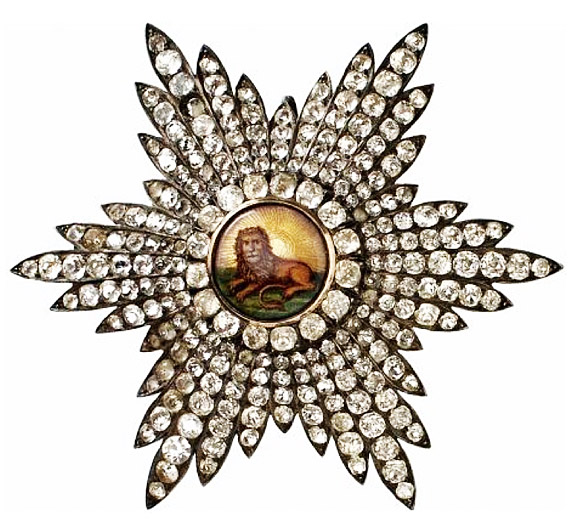 0
0 -
Thanks for posting the Russian beauties Nick. Yes I am fond of these! LOL! I tried researching the NB and PL sliver marks and came up empty. The small medal has Russian Assay mark for sure. I was surprised that I couldn't find the makers with those marks. The Kokoshnik Mark is dated prior to 1908. I think they both are Russian made. It seems like a lot of the jeweled lion and suns were made by Russian makers.
0 -
Lol! I have read this story a few times before. Always comes up in my search for lions and suns. Thankfully it is much easier to acquire a Lion and Sun order today without groveling and A$$ kissing! However, it is the same burning desire to own a Lion and Sun medal that collectors have to this day.
0 -
Very nice Nick! These photos add valuable information to the history of the Lion & Sun order in regards to foreign military awards.
Great photos!
0 -
Very nice Michael! Seems like the proper ribbon would be a red ribbon and along the way sometime a dealer replaced my example with a green ribbon. I like the officer ribbon on yours. Quite a nice medal bar.
0 -
Officially instituted in 1852 and called the Nishan-i-Ilmi (Order of the Arts and Sciences) as a reward artistic and scientific merit for those who had achieved success in their studies at the recently founded Polytechnic College of Tehran. Later converted to a full scale state order of merit for the advancement of learning and dissemination of knowledge by scientists, writers, educators, artists, etc. (Thank You James Hoard for this information!) According to an article written by Robert Macnamara in OMSA publication, This order had four classes, beginning with a copper medal, then an eight-pointed badge, in silver and in gilt, and a ten-pointed badge in gilt for first class. The upper classes in particular were more or less reserved for foreign professors, many from Vienna, who staffed the institution. Another school was founded at the same time as the Polytechnic College of Tehran, The Dar al-Funun military academy. This medal with military style of Lion and Sun with sword could have been related to the military accademy. Markus collection. Close up of the medallion.
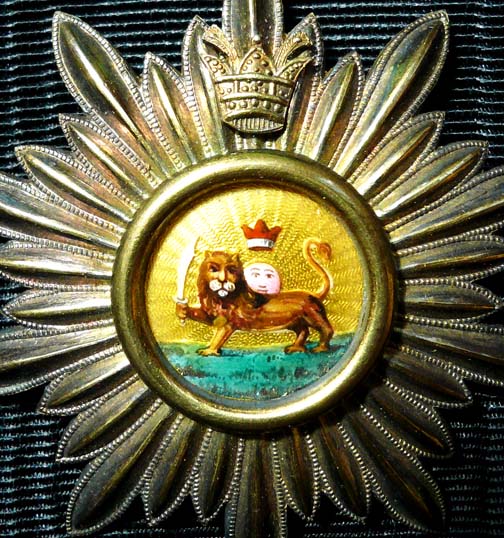 1
1 -
Officially instituted in 1852 and called the Nishan-i-Ilmi (Order of the Arts and Sciences) as a reward artistic and scientific merit for those who had achieved success in their studies at the recently founded Polytechnic College of Tehran. Later converted to a full scale state order of merit for the advancement of learning and dissemination of knowledge by scientists, writers, educators, artists, etc. (Thank You James Hoard for this information!) According to an article written by Robert Macnamara in OMSA publication, This order had four classes, beginning with a copper medal, then an eight-pointed badge, in silver and in gilt, and a ten-pointed badge in gilt for first class. The upper classes in particular were more or less reserved for foreign professors, many from Vienna, who staffed the institution. Another school was founded at the same time as the Polytechnic College of Tehran, The Dar al-Funun military academy. This medal with military style of Lion and Sun with sword could have been related to the military accademy. This medal was in it's original Halley Lasne box. Markus collection.
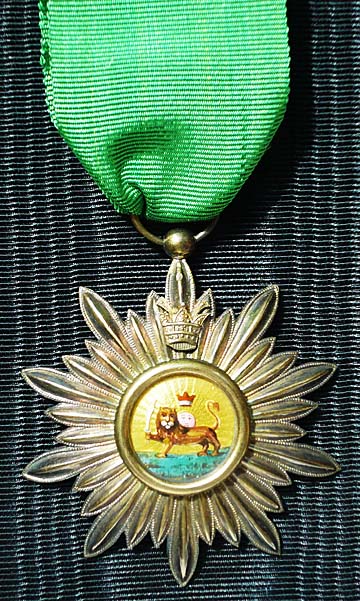
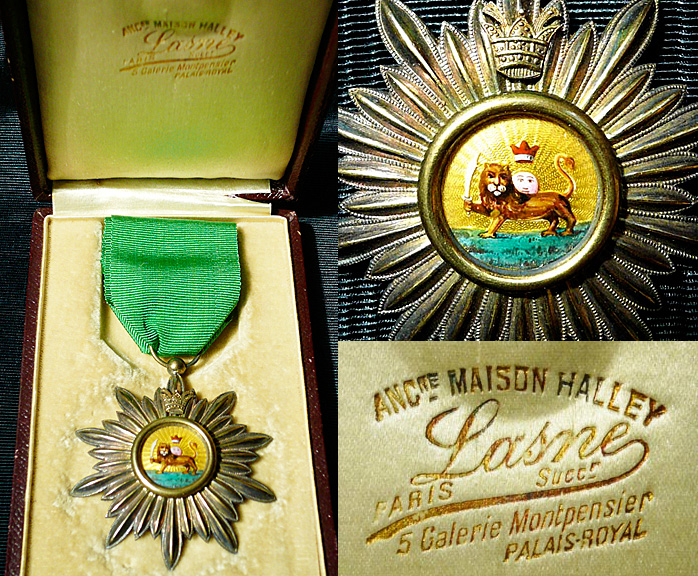 1
1 -
Officially instituted in 1852 and called the Nishan-i-Ilmi (Order of the Arts and Sciences) as a reward artistic and scientific merit for those who had achieved success in their studies at the recently founded Polytechnic College of Tehran. Later converted to a full scale state order of merit for the advancement of learning and dissemination of knowledge by scientists, writers, educators, artists, etc. (Thank You James Hoard for this information.) According to an article written by Robert Macnamara in OMSA publication, This order had four classes, beginning with a copper medal, then an eight-pointed badge, in silver and in gilt, and a ten-pointed badge in gilt for first class. The upper classes in particular were more or less reserved for foreign professors, many from Vienna, who staffed the institution. Spada Collection, exhibited in The Legion of Honor Museum Paris France.
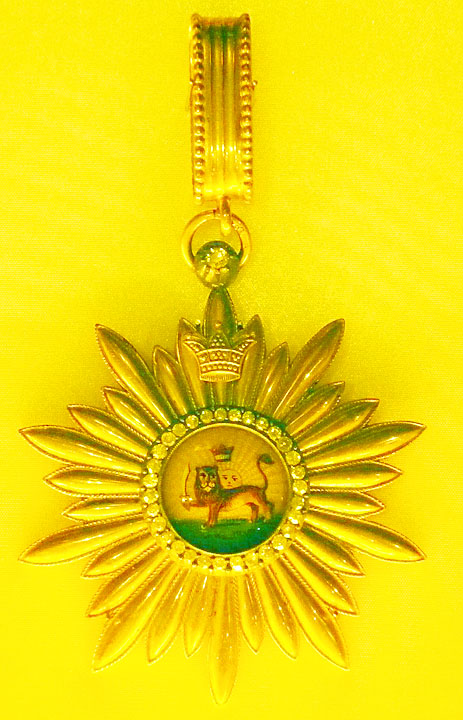 1
1 -
Officially instituted in 1852 and called the Nishan-i-Ilmi (Order of the Arts and Sciences) as a reward artistic and scientific merit for those who had achieved success in their studies at the recently founded Polytechnic College of Tehran. Later converted to a full scale state order of merit for the advancement of learning and dissemination of knowledge by scientists, writers, educators, artists, etc. (Thank You James Hoard for this information.) According to an article written by Robert Macnamara in OMSA publication, This order had four classes, beginning with a copper medal, then an eight-pointed badge, in silver and in gilt, and a ten-pointed badge in gilt for first class. The upper classes in particular were more or less reserved for foreign professors, many from Vienna, who staffed the institution. A grouping of various types. Private Collection.
 1
1 -
Officially instituted in 1852 and called the Nishan-i-Ilmi (Order of the Arts and Sciences) as a reward artistic and scientific merit for those who had achieved success in their studies at the recently founded Polytechnic College of Tehran. Later converted to a full scale state order of merit for the advancement of learning and dissemination of knowledge by scientists, writers, educators, artists, etc. (Thank You James Hoard for this information!) According to an article written by Robert Macnamara in OMSA publication, This order had four classes, beginning with a copper medal, then an eight-pointed badge, in silver and in gilt, and a ten-pointed badge in gilt for first class. The upper classes in particular were more or less reserved for foreign professors, many from Vienna, who staffed the institution. Private collection.
 1
1 -
Thanks James!
Your information helps immensely with dating some of these lions and suns. Always learning something new here on GMIC and appreciate you sharing your knowledge.
Markus
0 -
Hi James,
Wow it is great to have a scholar with so much depth on Persian order medals! I read the Persian medal Firman statues of 1834 and it states that gem laden Lion & Sun medals were replaced with silver work medals. Do you think the practice of adding jewels or paste stones to the Lion & Sun medal continued after 1834 to suit the taste of the owner or silver ones completely replaced that practice? The posts of #20,#36,#41,#43 & #76 in this thread illustrate the jeweled Lion & Suns. I was wondering if it was safe to date the jeweled medals pre-1834. The other question is on the stars between the rays on some of the 1st & 2nd class breast stars. Does this design incorporating stars between rays end at some point or does the practice continue throughout the history of the Lion & Sun order making. Thanks!
Markus
0 -
James,
Thanks for all your input. I suspect now that the original Firmans for Lion & Sun Orders are crumbling into oblivion some where in Iran. It is too bad that Iranian government dislikes all their royal history so much and choses not to preserve it.
This Firman I am posting is in the collection of His Highness the Aga Khan. It is a Royal order of Fath Ali Shah honoring Sir Harford Jones circa March 1809. The Persian script and art work are quite amazing.
Markus
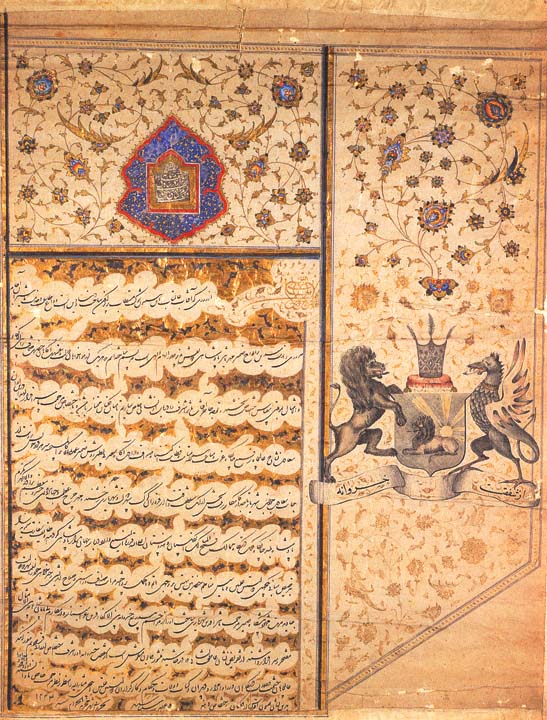 1
1 -
Hello James,
Thanks so much for your contributions to understanding of this order. It is great to get reliable information on this complex and confusing order. Are your copies of the Firmans in original form with Persian script or translations? It is my understanding that the original Firmans had beautiful illustrated paintings as well. Could you possibly post a copy of Persian Firman script or illustrations just to get the flavor? Just a portion or close up would be great.
Markus
0 -
Hi Michael,
Thanks for your post. I tried finding a copy of this book for sale on line and could not. It appears that it was written in the english language. Do you have this book in your possession to pull out more details? If you know where I can purchase this book please let me know. I have been searching for more sources on the Persian Lion & Sun order.
Thanks, Markus
0 -
This is a full set of the order that recently was on Hermann Historica site.
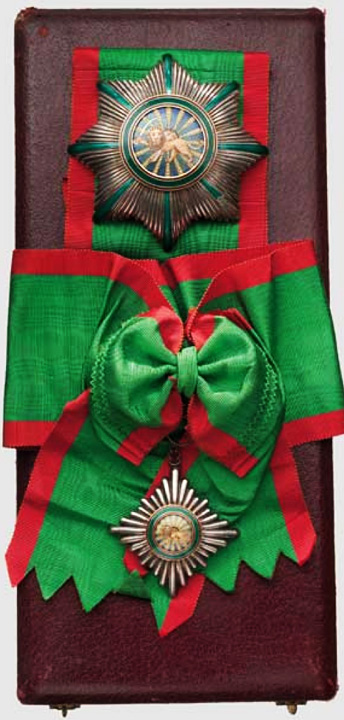 1
1 -
Here is another version of this order courtesy of Babar. The 360 degrees sun rays and bearded lion are fantastic! Usually they were made by Bertrand in Paris. I have seen the breast star with green ray, no green rays, and a bearded lion with 360 degree sun rays.
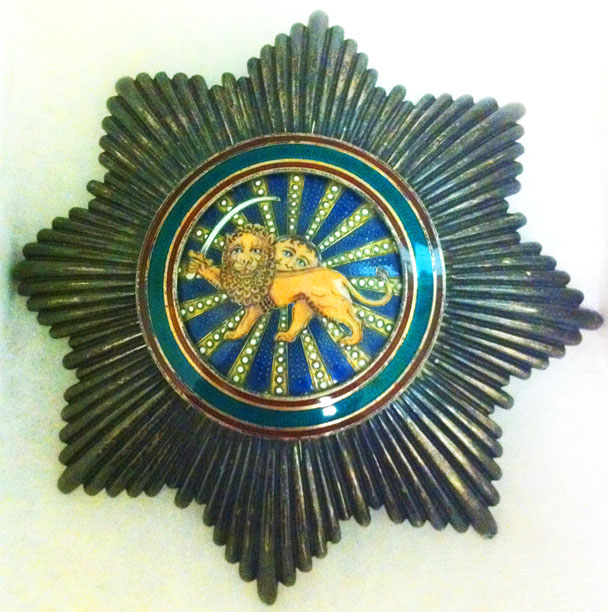 1
1 -
Hi Nick,
Thanks for this nice thread! This does back up your theory about laying lions are for foreigners. Come to think of it, when ever they are in medal bar awarded to a foreign military person, they always are laying down. Do you think within Persia a distinction is made between civil and military? The iranian websites detailing this order always say, " Laying down lions are civil, sword lions military" Now we need to find a Persian civil servant award with documentation.
Markus
0 -
Hi Swoop737,
They have been pretty scarce lately but occasionally pop up on dealer sites or auctions houses. One auction house had a few sets lately. Their hammer prices will give you an idea what they are selling for. Their prices were lower than a lot of dealer prices.
http://www.hermann-h...e-kataloge.html
Markus
0 -
Close up of the medallions. Early Persian made breast stars.
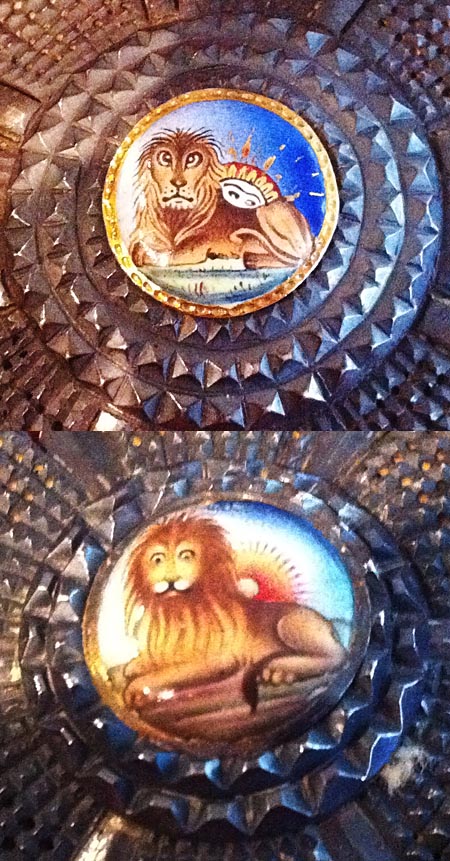 0
0 -
Here are two early Persian breast stars with beautiful enamel paintings. Photos courtesy of Babar.
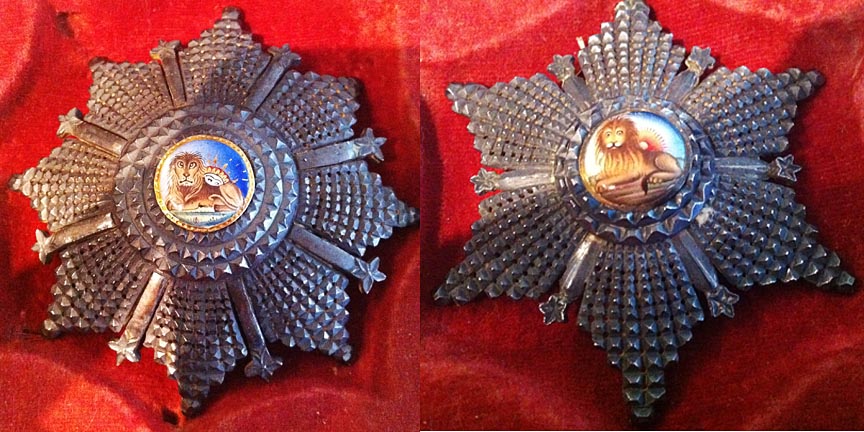 0
0 -
This is a photo I am posting for Babar of an incredible Lion and Sun medal that will be exhibited in the forthcoming Aga Khan Museum opening in Toronto in 2013. Looks like it was owned by the Aga Khan himself (I'm guessing here). WOW! Thanks Babar!
"His Highness the Aga Khan has taken the initiative to create a museum of Muslim culture: the Aga Khan Museum, in Toronto, Canada. Due to open in 2013, the Museum will be established as a permanent institution with an international scope and mission. It is dedicated to the collection, research, preservation and display of works of art, objects and artefacts of artistic, cultural and historical significance from various periods and geographic areas of the Muslim world."
http://www.akdn.org/publications/akm_project_brief.pdf
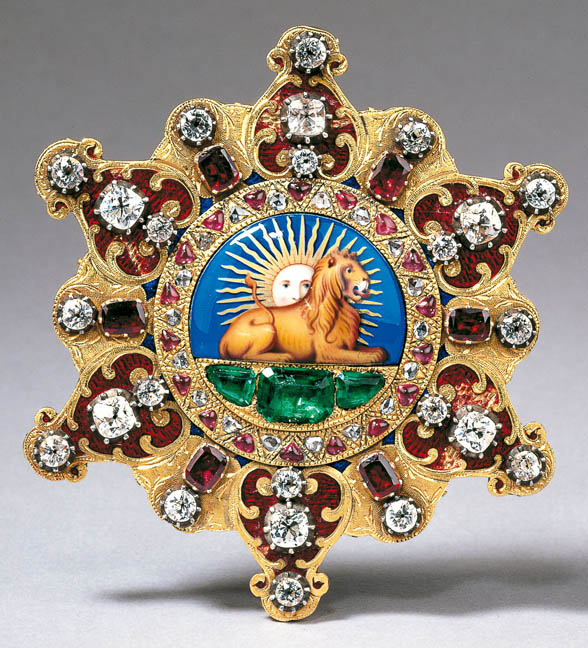 0
0 -
Thanks Gavin! I would tend to believe an Iranian site drawing on persia and Iranian documents for authenticity over other sites.
0 -
Very nice medals, thanks Babar!
0




Persia - Order of the Lion and the Sun
in Middle East & Arab States
Posted · Edited by Markus
These jeweled Lion and Suns must melt the collector's heart and wallet like a diamond engagement ring melts the woman's heart and the man's wallet!
It seems that whenever one of these jeweled Lion and Suns is auctioned, a new record is set.